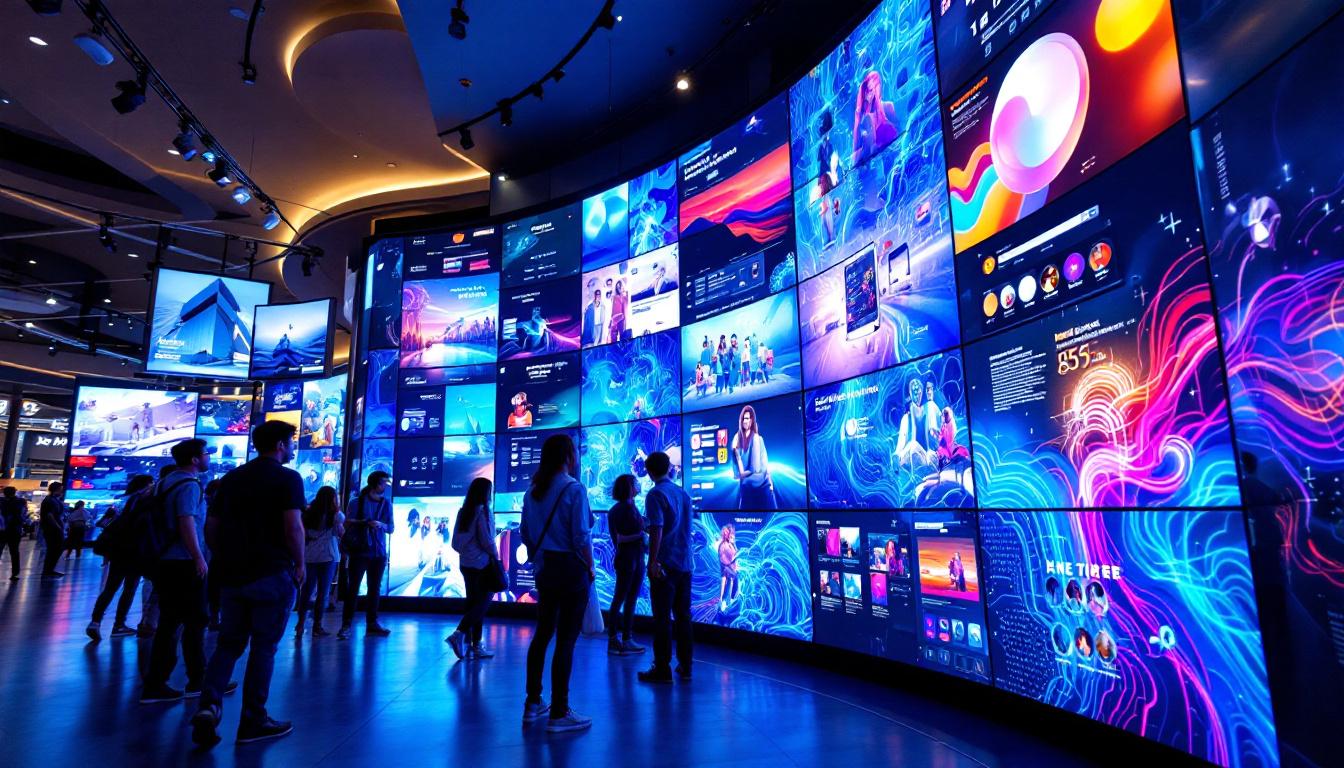In the rapidly evolving healthcare industry, technology plays a pivotal role in enhancing patient care and operational efficiency. One such technological advancement gaining significant traction is the use of LED displays in medical settings. Vds Medical, a leader in healthcare technology solutions, has been at the forefront of integrating LED display technology into medical environments. This article delves into the intricacies of LED displays, their applications in healthcare, and why Vds Medical’s approach stands out in the market.
Understanding LED Display Technology
What is an LED Display?
LED stands for Light Emitting Diode, a semiconductor device that emits light when an electric current passes through it. An LED display is a flat panel display that uses an array of light-emitting diodes as pixels for a video display. These displays are known for their brightness, energy efficiency, and long lifespan, making them ideal for various applications, including medical environments.
Unlike traditional LCD or plasma screens, LED displays offer superior contrast ratios and color accuracy, which are critical in medical imaging and diagnostics. The ability to produce vivid images with high resolution ensures that healthcare professionals can rely on these displays for precise visual information. This is particularly important in fields such as radiology, where accurate interpretation of images can significantly impact patient outcomes. Moreover, the rapid response time of LED displays allows for real-time imaging, which is essential during surgical procedures and emergency care.
Types of LED Displays Used in Healthcare
There are several types of LED displays, each suited for different medical applications:
- Direct View LED Displays: These are large-scale displays composed of numerous LEDs directly emitting light. They are often used in operating rooms or large patient monitoring stations where visibility from a distance is essential. Their ability to maintain brightness in well-lit environments makes them particularly useful in settings where ambient light cannot be controlled.
- LED Backlit LCD Displays: These combine LED backlighting with LCD technology, offering thinner screens and energy efficiency. They are common in diagnostic equipment and bedside monitors. The integration of LED backlighting not only enhances the visual quality but also reduces power consumption, making them a sustainable choice for healthcare facilities.
- MicroLED Displays: An emerging technology that offers even higher resolution and brightness, MicroLEDs are poised to revolutionize medical imaging with their superior performance and durability. Their modular design allows for flexible configurations, making them ideal for customized medical applications, such as telemedicine or mobile health units.
In addition to these types, the adaptability of LED technology allows for innovative applications such as augmented reality in surgical settings. Surgeons can overlay critical imaging data directly onto their field of view, enhancing precision and reducing the risk of errors. Furthermore, the longevity of LED displays means that hospitals can invest in these technologies with confidence, knowing they will not only meet current demands but also adapt to future advancements in medical imaging and diagnostics.
As LED technology continues to evolve, we can expect to see even more sophisticated displays that incorporate artificial intelligence and machine learning capabilities. These advancements could enable real-time analysis of imaging data, providing healthcare professionals with actionable insights at their fingertips. This integration of technology not only enhances the efficiency of medical workflows but also improves patient care by facilitating quicker and more accurate diagnoses.
Applications of LED Displays in Medical Settings
Enhancing Diagnostic Accuracy
One of the most critical uses of LED displays in healthcare is in diagnostic imaging. Radiologists and other medical professionals rely on high-definition displays to interpret X-rays, MRIs, CT scans, and ultrasounds. LED displays provide sharper images with better contrast, enabling more accurate diagnoses.
For example, a study published in the Journal of Digital Imaging found that LED-backlit monitors improved the detection rate of subtle lesions in mammography compared to older display technologies. This improvement can lead to earlier detection of diseases such as cancer, significantly impacting patient outcomes. Moreover, the enhanced color accuracy and depth of LED displays allow for better differentiation between various tissue types, which is crucial in identifying abnormalities that could be easily overlooked on standard monitors.
Improving Surgical Precision
In operating rooms, LED displays are used to present real-time imaging, patient vitals, and surgical navigation data. The brightness and clarity of LED screens allow surgeons to view critical information without distraction, even under intense lighting conditions.
Vds Medical’s LED display solutions are designed with medical-grade standards, ensuring they meet the rigorous demands of surgical environments. Features such as anti-reflective coatings and adjustable brightness levels help maintain visibility and reduce eye strain during lengthy procedures. Furthermore, the integration of multi-screen setups can provide surgeons with a panoramic view of the surgical field, allowing for better spatial awareness and coordination when performing complex procedures.
Patient Monitoring and Communication
Beyond diagnostics and surgery, LED displays play a vital role in patient monitoring systems. These displays provide continuous updates on vital signs such as heart rate, oxygen saturation, and blood pressure. The clarity and reliability of LED technology ensure that healthcare providers can quickly identify any changes in a patient’s condition.
Additionally, LED displays are used in patient rooms and waiting areas to communicate important information, educational content, or even calming visuals to improve patient experience. Vds Medical integrates customizable LED display solutions that can be tailored to specific healthcare facility needs. This adaptability allows hospitals to showcase personalized messages for patients, such as treatment plans or wellness tips, fostering a more engaging and informative environment. Moreover, the use of soothing imagery or nature scenes on these displays can help reduce anxiety and create a more comforting atmosphere for patients and their families during stressful times.
Advantages of Vds Medical LED Displays
Medical-Grade Quality and Compliance
Vds Medical emphasizes compliance with international medical device standards, including IEC 60601-1, which governs the safety and performance of medical electrical equipment. Their LED displays undergo rigorous testing to ensure they do not interfere with other medical devices and maintain consistent performance under various conditions.
This commitment to quality is crucial because medical environments demand equipment that is reliable, safe, and durable. Vds Medical’s LED displays are designed to withstand frequent cleaning with hospital-grade disinfectants, an essential feature to prevent healthcare-associated infections.
Energy Efficiency and Sustainability
Hospitals and clinics are increasingly focused on reducing energy consumption and environmental impact. LED technology inherently consumes less power compared to traditional display technologies, helping healthcare facilities lower their energy bills and carbon footprint.
Vds Medical’s LED displays incorporate energy-saving features such as automatic brightness adjustment based on ambient light and power management modes. These innovations not only contribute to sustainability goals but also reduce operational costs, a significant consideration for healthcare administrators.
Customization and Integration Capabilities
Every healthcare facility has unique requirements, and Vds Medical offers customizable LED display solutions to meet diverse needs. Whether it’s a compact display for a portable ultrasound machine or a large video wall for a hospital command center, Vds Medical works closely with clients to tailor products accordingly.
Moreover, their displays are designed for seamless integration with existing medical systems and software, ensuring smooth workflows and data interoperability. This integration capability is essential for maintaining efficient healthcare operations and enhancing patient care coordination.
Challenges and Considerations in Implementing LED Displays
Initial Investment and Cost-Benefit Analysis
While LED displays offer numerous advantages, the initial investment can be substantial, especially for high-resolution, large-format screens. Healthcare facilities must conduct thorough cost-benefit analyses to justify the expenditure.
However, the long-term benefits, including improved diagnostic accuracy, reduced maintenance costs, and energy savings, often outweigh the upfront costs. Vds Medical provides comprehensive support and financing options to help institutions manage these investments effectively.
Ensuring Compatibility with Medical Software
Another consideration is ensuring that LED displays are fully compatible with the specialized medical software used in diagnostics, imaging, and patient monitoring. Incompatibility can lead to display errors or delays, potentially affecting patient care.
Vds Medical addresses this challenge by collaborating with software providers and conducting extensive compatibility testing. Their technical teams also offer ongoing support to troubleshoot and optimize system performance.
Training and User Adoption
Introducing new technology requires adequate training for healthcare professionals to maximize its benefits. LED displays, with their advanced features and customization options, may necessitate additional user education.
Vds Medical offers comprehensive training programs and user manuals to facilitate smooth adoption. By empowering medical staff to utilize LED displays effectively, healthcare facilities can enhance workflow efficiency and patient outcomes.
The Future of LED Displays in Healthcare
Emerging Technologies and Innovations
The future of LED displays in healthcare looks promising, with ongoing innovations such as flexible and transparent LED screens, higher pixel densities, and integration with augmented reality (AR) and artificial intelligence (AI) systems.
For instance, MicroLED technology is expected to deliver unprecedented image quality and durability, while AR-enabled LED displays could assist surgeons by overlaying critical information directly onto the surgical field. Vds Medical is actively investing in research and development to bring these cutting-edge solutions to market.
Expanding Applications Beyond Traditional Settings
LED displays are also finding applications beyond hospitals and clinics. Telemedicine platforms, mobile health units, and home care devices increasingly incorporate LED screens to facilitate remote monitoring and patient engagement.
Vds Medical’s flexible LED display solutions cater to these expanding markets, supporting the broader trend of decentralized and patient-centered healthcare delivery.
Conclusion
LED display technology is transforming the healthcare landscape by enhancing diagnostic precision, surgical accuracy, and patient monitoring capabilities. Vds Medical’s commitment to quality, customization, and innovation positions it as a key player in this transformation.
As healthcare continues to embrace digital solutions, the integration of advanced LED displays will be instrumental in improving patient outcomes and operational efficiency. Understanding the technology, its applications, and the benefits offered by providers like Vds Medical is essential for healthcare administrators and professionals aiming to stay at the forefront of medical innovation.
Discover LumenMatrix’s Advanced LED Display Solutions
As the healthcare sector continues to advance, the integration of LED display technology is proving to be a game-changer in medical diagnostics and patient care. Embrace the future with LumenMatrix, a pioneer in crafting immersive visual experiences through their comprehensive range of LED display modules. From enhancing operating rooms with Indoor LED Wall Displays to engaging patients with Custom LED Displays, LumenMatrix is committed to revolutionizing visual communication in healthcare. Check out LumenMatrix LED Display Solutions today and witness how their innovative technology can transform your medical facility’s approach to care delivery and communication.































